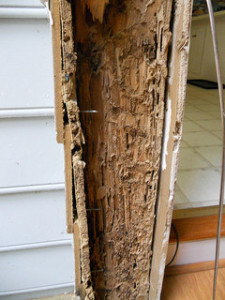Termites Are Attracted by Certain Conditions
By Chris Williams on May 22, 2015.

Here in Massachusetts and New Hampshire, our only serious termite pest is the eastern subterranean termite… and it can be plenty serious! It’s called a subterranean termite because it has a mandatory association with the soil. These termites live in underground nests where they can maintain a high level of humidity. They forage from these nests, through soil, looking for damp or rotting wood that they can feed on. If they find wood that is above ground, they build mud tubes to reach it so that they are protected from predators and the dry outside air.
Wood-to-Soil Contact is the #1 Cause of Termite Infestation
Because subterranean termites require soil and wood to survive, it follows that wood that is in direct contact with the ground is most susceptible to termite attack. When any kind of a wooden structure is built, the soil around it is first treated with a pesticide to kill or repel foraging termites. That treatment doesn’t last forever. And, homeowners may also inadvertently create new conditions that make termite infestation more likely.
When we visit a customer’s home for a termite inspection, whether we find termites or not, we often find what we call “conducive conditions.” These are situations around the home and yard that would be especially attractive to termites and could result in a termite infestation. Most of these conducive conditions involve wood-to-ground contact, or conditions where wood is damp or wet. For a list of typical conducive conditions, see Are You Inviting Termites Into Your Home?
About 90% of termite infestations in structures can be traced to wood that is in contact with the soil. When this happens, termites can move directly from the soil into the wood, no need for protective mud tubes. This also means that they can infest the wood while remaining unseen. Some often-overlooked conducive conditions are wood siding or latticework that touches the ground, or door or basement window frames that are less than 6 inches above grade. Deck supports, or wooden porches and steps installed directly on soil are susceptible to termite attack.
Conditions Around The Foundation Can Attract Termites
Maintenance situations around the foundation of a home can encourage termite activity — things like heavy, damp mulch, woodpiles or wood debris on the ground, even wood scraps, cardboard boxes or newspapers left in a crawlspace. Moisture problems around a home can mean damp wood that is attractive to termites. Roof leaks, plumbing leaks, crawlspace condensation, and gutters and downspouts that direct water towards the foundation rather than away, all are considered to be “conducive conditions.”
For more on finding and correcting conducive conditions around your home, check out these blogs: